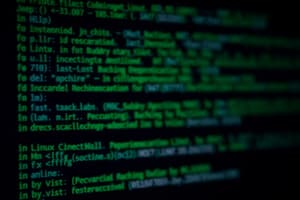Podcast
Questions and Answers
What distinguishes Linux from other operating systems?
What distinguishes Linux from other operating systems?
- It is exclusively used for server applications.
- It only supports software from specific vendors.
- It does not require any hardware to operate.
- It is open-source and community-driven. (correct)
Which of the following is NOT a type of Linux shell?
Which of the following is NOT a type of Linux shell?
- Powermode (correct)
- Zsh
- Tcsh
- Bash
Which file system belongs to the Ext family commonly used in Linux?
Which file system belongs to the Ext family commonly used in Linux?
- Ext4 (correct)
- HFS+
- FAT32
- NTFS
What is the primary role of the Linux kernel?
What is the primary role of the Linux kernel?
Who was a key contributor to the development of Linux?
Who was a key contributor to the development of Linux?
Which of the following is NOT a common Linux distribution?
Which of the following is NOT a common Linux distribution?
What is the primary function of a boot loader in Linux?
What is the primary function of a boot loader in Linux?
Which of the following best describes a package management system?
Which of the following best describes a package management system?
Which desktop environment is NOT commonly associated with Linux systems?
Which desktop environment is NOT commonly associated with Linux systems?
What is one feature that distinguishes Debian from other Linux distributions?
What is one feature that distinguishes Debian from other Linux distributions?
Study Notes
Operating System (OS) Basics
- Operating systems are software that manage computer hardware and software resources.
- They provide a platform for applications to run efficiently.
- They provide a user interface for interacting with the computer.
Linux Overview
- Linux is a Unix-like operating system known for its stability, flexibility, and open-source nature.
- It is used in diverse systems, from embedded devices to supercomputers.
What is GNU/Linux?
- GNU/Linux is a combination of the GNU operating system components and the Linux kernel.
- The GNU project provides essential tools and libraries, while the Linux kernel manages the system's core functionality.
History of Linux
- The Linux kernel was created by Linus Torvalds in 1991.
- It was based on the Unix operating system.
- It's considered a success story in free and open-source software development.
Importance of Linux
- It is a highly stable and secure operating system.
- It is very customizable and flexible, allowing users to tailor it to their needs.
- It is free and open-source, making it accessible to everyone.
- It has become a standard for servers, embedded systems, and high-performance computing.
Key Contributors
- Linus Torvalds - creator of the Linux kernel
- Richard Stallman - founder of the GNU Project
- Andrew Tanenbaum - developer of the Minix operating system, which influenced Linux
Linux Kernel
- The heart of the Linux operating system, it manages the system's resources and hardware.
- It is responsible for tasks like memory management, process scheduling, and device drivers.
- It is constantly being developed and improved by a worldwide community.
Types of Kernels
- Stable kernels: Released with regular updates and bug fixes, they are suitable for production environments.
- Long-term support (LTS) kernels: Receive security updates and bug fixes for a longer duration, often recommended for servers.
- Development kernels: Contain cutting-edge features and may be unstable, mainly used by developers.
- Custom kernels: Built from source code, allowing customization for specific hardware or needs.
- Real-time kernels: Optimized for low latency and high performance, suitable for applications needing precise timing.
Linux vs. Other Operating Systems
- Linux is generally considered more stable and secure.
- Compared to Windows, Linux is lightweight and resource-efficient.
- It is more customizable and flexible than macOS, allowing users to tailor it to their needs.
Popular Linux Distributions
- Debian: Stable, well-established, and widely used in servers and desktop environments.
- Ubuntu: Popular for its user-friendliness, large community, and wide software selection.
- Fedora: Cutting-edge features, latest software releases, and a focus on innovation.
- CentOS: Known for its stability, long-term support, and use in enterprise environments.
Licensing
- Linux and most GNU/Linux distributions are licensed under free and open-source licenses.
- This allows users to freely use, modify, and distribute the software.
Common Mistakes for New Linux Users
- Expecting everything to be like Windows or macOS.
- Not understanding the command line interface.
- Assuming that Linux distributions are all the same.
- Not reading the documentation.
Linux Kernel Version 5.9 (October 2020)
- This version introduced new features like support for AMD Zen 3 processors and improved power management.
- It contained bug fixes and security updates.
Linux in the Modern World
- Linux is a vital part of the internet infrastructure, powering countless servers and websites.
- It is widely used in embedded systems, such as smartphones and smart TVs.
- It is gaining popularity in the desktop computing space.
What is a Shell?
- A shell is a user interface that allows users to interact with the Linux kernel.
- It interprets commands typed by the user and executes them.
- It provides a way to manage files, processes, and system resources.
Types of Shells in Linux
Bash (Bourne Again Shell)
- The default shell in many Linux distributions.
- User-friendly with a wide range of features.
- Comes with various built-in commands.
- Offers scripting capabilities.
Zsh (Z Shell)
- A powerful and customizable shell.
- Offers advanced features like tab completion and plugin support.
- Provides a rich environment for scripting and automation.
Fish (Friendly Interactive Shell)
- Known for its user-friendly nature.
- Offers features like syntax highlighting and web-style command completion.
- Easy to learn and use, especially for beginners.
Ksh (Korn Shell)
- A robust and comprehensive shell.
- Offers a combination of Bash and C shell features.
- Widely used in scripting and system administration.
Csh (C Shell)
- Inspired by the C programming language.
- Offers a streamlined syntax and alias functionality.
- Primarily used in scripts and system administration.
Tcsh (TENEX C Shell)
- An enhanced version of Csh.
- Offers improved features and capabilities such as command history and completion.
- Still used in some environments.
Comparison Table of Shells
| Shell | Description | Popularity | Features |
|---|---|---|---|
| Bash | Standard Unix shell, default in many Linux distributions | Very popular | Wide array of commands, user-friendly, scripting support |
| Zsh | Powerful and customizable shell | Growing in popularity | Advanced features, tab completion, extensive plugins |
| Fish | User-friendly shell with modern features | Gaining traction | Syntax highlighting, web-style completion, beginner-friendly |
| Ksh | Robust and comprehensive shell | Popular in scripting and system administration | Combines features from Bash and C shell |
| Csh | Inspired by the C programming language | Used in scripts and system administration | Streamlined syntax, alias functionality |
| Tcsh | Enhanced version of Csh | Less used, but still has a following | Improved features and capabilities, command history and completion |
Linux File System Overview
- It is a hierarchical system where data is organized into files and directories.
- Files are stored in directories, and directories can contain other directories.
- It is the foundation of the Linux operating system, managing data storage and organization.
Common Linux File Systems
Ext Family
- Ext2 - (1993)
- Ext3 - (2001)
- Ext4 - (2008) - The current default filesystem for most Linux distributions.
- Offers features like journaling, allowing for better performance and data integrity.
- XFS - (1993)
Btrfs (2009)
- Offers advanced features like snapshotting, copy-on-write, and data integrity checks.
- It is a future file system for Linux, designed for stability and performance.
ReiserFS (2001)
- Known for its fast performance and efficient storage utilization.
- It combines the best aspects of other file systems.
Windows File Systems (for comparison)
- ** FAT32 -** older file system, used for external drives and older systems.
- NTFS - The primary system for modern Windows versions.
- exFAT - used for external storage devices, supports larger file sizes.
Linux Directory Structure
- The root directory (/) is the top-level directory.
- Every other directory and file is located within it.
Common Directories
- ** /bin -** contains essential user commands.
- ** /boot -** contains files for booting the operating system.
- ** /dev -** contains device files that represent hardware devices.
- ** /etc -** contains configuration files for the system.
- ** /home -** contains user home directories.
- ** /lib -** contains system libraries.
- ** /media -** contains removable media, like USB drives and DVDs.
- ** /mnt -** contains temporary mount points for filesystems.
- ** /opt -** contains additional software packages.
- ** /proc -** contains information about running processes.
- ** /root -** contains the root user's home directory.
- ** /run -** contains runtime data.
- ** /sbin -** contains essential system commands.
- ** /srv -** contains data for services.
- ** /sys -** contains information about the system's hardware.
- ** /tmp -** contains temporary files.
- ** /usr -** contains user applications and system data.
- ** /var -** contains variable data, such as log files and temporary data.
Additional Subdirectories
- ** /usr/bin -** contains user commands.
- ** /usr/lib -** contains user libraries.
- ** /usr/sbin -** contains user system commands.
Desktop Environments (DEs)
- GNOME: User-friendly, popular in many Linux distributions.
- KDE Plasma: Highly customizable with many features.
- Xfce: Lightweight and resource-efficient, ideal for older systems.
- Cinnamon: Offers a traditional desktop experience, inspired by GNOME 2.
- MATE: A fork of GNOME 2, providing a familiar desktop layout.
Installing Linux and Desktop Environments (DE)
- Dual booting: Install Linux alongside an existing operating system like Windows.
- Virtual machine: Run Linux as a virtual machine within another operating system.
- Full installation: Replace the existing operating system with Linux.
Package Management Systems
- APT (Advanced Packaging Tool): Used by Debian-based distributions like Ubuntu.
- Yum (Yellowdog Updater, Modified): Used by Red Hat-based distributions like Fedora.
- Pacman: Used by Arch Linux.
- Dnf (Dandified Yum): Used by Fedora.
Boot Loaders
- GRUB (Grand Unified Bootloader): Offers a menu to choose between operating systems installed on the system.
- systemd-boot: A faster and more modern bootloader, often used in newer Linux distributions.
- LILO (Linux Loader): An older bootloader, still used in some legacy systems.
- EFI (Extensible Firmware Interface): A modern boot standard that replaces the BIOS in most new computers.
Linux Distributions
- Debian-based: Ubuntu, Mint, elementary OS, Pop!_OS
- Red Hat-based: Fedora, CentOS, RHEL, Oracle Linux
System Installers
- Live installation: Allows you to try out the operating system without installing it permanently.
- Full installation: Installs the operating system on your hard drive.
Command Cheat Sheet for Package Management
- apt update - Updates the package list.
- apt upgrade - Upgrades all installed packages.
- apt install <package_name> - Installs a specific package.
- **apt remove ** - Removes a specific package.
- apt autoremove - Removes unused dependencies.
- apt search <search_term> - Searches for packages matching the search term.
1. Arch Linux
- A rolling release distribution known for its flexibility and user control.
- Requires a higher level of technical knowledge.
- Follows a minimalist approach with no pre-installed desktop environment.
2. SUSE Linux
- A stable and reliable distribution with a strong focus on enterprise use.
- Offers comprehensive support and a user-friendly interface.
3. Slackware Linux
- One of the oldest Linux distributions.
- Known for its simplicity and stability, it is still used in many embedded systems.
4. Debian
- A stable and well-established distribution.
- Used as the base for many other Linux distributions such as Ubuntu.
5. Red Hat Linux
- Focused on enterprise use.
- Known for its robust security and stability.
6. Knoppix
- Live distribution designed to be used from a CD or USB drive without installation.
- It is popular for its wide range of tools and applications.
7. Gentoo Linux
- Users compile software from source code, offering maximum customization and optimization.
- Requires a higher level of technical expertise.
8. Fedora
- Focused on innovation, Fedora regularly incorporates cutting-edge technologies.
- Offers a fast-paced development cycle and a strong community.
9. CentOS
- A community-supported version of Red Hat Enterprise Linux (RHEL).
- Known for its stability and long-term support.
10. Ubuntu
- A popular distribution for its vast user-base and extensive software library.
- Known for its user-friendliness and stability, it has become the standard for many users.
11. Alpine Linux
- A minimalist distribution known for its lightweight footprint and security.
- Optimized for resource-constrained environments.
12. Oracle Linux
- Enterprise Linux distribution built by Oracle.
- Provides support and a wide range of features for businesses.
- Compatible with Red Hat Enterprise Linux applications.
13. Android
- Based on the Linux kernel.
- Primarily a mobile operating system, used in smartphones and tablets.
14. Desktop Environments
- GNOME: User-friendly, popular in many Linux distributions.
- KDE Plasma: Highly customizable with many features.
- Xfce: Lightweight and resource-efficient, ideal for older systems.
- Cinnamon: Offers a traditional desktop experience, inspired by GNOME 2.
- MATE: A fork of GNOME 2, providing a familiar desktop layout.
15. Display Servers
- Xorg: The most common display server for Unix-like systems, including Linux.
- Wayland: A new display server protocol designed to replace Xorg, offering improved performance and security.
16. Display Managers
- GDM (GNOME Display Manager): The default display manager for GNOME.
- KDM (KDE Display Manager): The default display manager for Plasma.
- SLiM (Simple Login Manager): A lightweight and customizable display manager.
Distributions Overview
1. Kali Linux
- Designed for penetration testing and security auditing.
- Contains a wide range of security tools and resources.
2. Ubuntu Linux
- A popular distribution for its user-friendliness, large community, and wide software selection.
- Known for its stability and ease of use.
3. Fedora Linux
- Focused on innovation and cutting-edge technologies.
- Offers a fast-paced development cycle and a strong community.
4.
Studying That Suits You
Use AI to generate personalized quizzes and flashcards to suit your learning preferences.
Related Documents
Description
Test your knowledge of the Linux operating system with this quiz. Questions cover distinctions of Linux, various Linux shells, file systems, the role of the Linux kernel, and key contributors to its development. Ideal for beginners seeking to understand the fundamentals of Linux.




